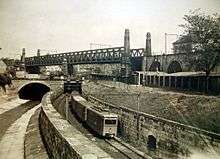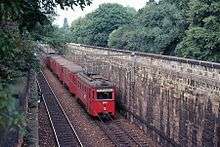Wiener Stadtbahn

The Wiener Stadtbahn (German for "Vienna Metropolitan Railway") was a public transportation system operated under this name from 1898 to 1989. Today, the Vienna U-Bahn lines U4 and U6 and the Vienna S-Bahn (rapid transit) run on its former lines.
The name derives from the usage of the term around the turn of the 19th/20th century to denote a full-scale railway in an urban area, separated from all other forms of traffic. It is not related to the usage of the term Stadtbahn in post-World War II Germany.
The Stadtbahn is one of Vienna's better-known examples of early Art Nouveau architecture. Its most famous buildings are the two former station entrances on Karlsplatz, now used as a café and a museum respectively, and the Hofpavillon, a station built specifically for Emperor Franz Joseph, located at the eastern end of Hietzing station. Other preserved historical stations are the elevated stations along the Gürtel and in some of the suburbs.
History



The Stadtbahn was built between 1894 and 1901 along with the regulation of the Wien River and the Danube Canal. Only five lines of a much larger planned network were actually constructed:
- Wientallinie (Vienna Valley line): Hütteldorf-Hacking - Hauptzollamt
- Donaukanallinie (Danube Canal line): Hauptzollamt - Heiligenstadt
- Line to the 2nd district: Hauptzollamt - Praterstern
- Gürtel line: Meidling Hauptstrasse - Westbahnhof - Heiligenstadt
- Vorortelinie (Suburban line): Hütteldorf-Hacking - Ottakring - Heiligenstadt
In addition, a brief section of elevated track was built connecting the Gürtel and Danube Canal lines between Nussdorfer Strasse and Friedensbrücke stations.
Of the lines that were not built, two lines should have crossed the inner city, and one would have extended the Gürtel line along the southern Gürtel road to Südbahnhof railway station. These would have helped the Stadtbahn be a more appealing and useful transportation system, but financial constraints prevented their construction.
The layout of the Vienna railway network was also influenced by its uses for the military which demanded full compliance with mainline railroad rules, steam propulsion and integration with ordinary rail service; this increased costs compared to electrical light rail option. When the lines opened, in four stages between 1898 and 1901, they failed to attract mass riders due to high costs; affluent passengers were discouraged by dirt from engine smokestacks and slow speed. While primarily an urban railway line, some trains continued on the mainlines to the north and west of the city.
In 1918, services came to a halt due to the coal shortage after World War I. Subsequently, the Wiental, Donaukanal, and Gürtel lines were leased by the city of Vienna. They were electrified and reopened in 1925 under the name "Wiener Elektrische Stadtbahn" (Vienna Electric Metropolitan Railway).
Under the new line scheme, each line was assigned a single letter (D (Donaukanal), G (Gürtel) und W (Wienfluss)) which could be combined with other letters to indicate the lines served (like G, GD, DG, and WD). Also notable is line 18G, which was operated until 1945 and ran from Heiligenstadt to Gumpendorfer Strasse station and then along the course of tram line number 18 to Ostbahnhof railway station.
Many stations and numerous sections of the lines were destroyed in World War II. Reconstruction of the lines took until 1955, and some of the historic stations were never rebuilt. In 1968 it was decided to integrate the Stadtbahn lines into the city's new subway system. Conversion of line WD to line U4 was completed in 1981; conversion of lines G and GD to line U6 in 1989. Since then, the term "Stadtbahn" has disappeared from official use.

Rolling stock

A special type of steam engine, kkStB class 30, was designed by the Austrian engineer Karl Gölsdorf specifically for use on the Stadtbahn. The engine was optimized for quick acceleration, to suit the tight curves and steep inclines of the lines, and to emit a minimum of smoke, which was essential for the tunnel sections. The passenger cars were 2-axle trailers that were rather freely based on a design by Otto Wagner.
The new type of rolling stock introduced after electrification was designed so that it could also run on the tramway network. It consisted of 2-axle motor cars (class N), heavy trailers (class n) and light trailers (class n1), which were combined to form trains of up to nine cars in length. These were in operation until 1964.
From the mid-1950s onwards, these cars were completely rebuilt using steel frames and new electric equipment. These were referred to as class N1 (motor cars) and class n2 (trailers) and were used well into the 1980s.
From 1980 onwards, the class N1 and n2 cars were gradually replaced by new six-axle articulated cars. These are referred to as class E6 (motor cars) and c6 (trailers) and are based on the Duewag "Mannheim" design. These were in service until the Stadtbahn service officially ended in 1989.
Conversion to U-Bahn

From 1976 onwards, the Stadtbahn was integrated into the newly established Vienna U-Bahn system. For line U4, most of the stations of the Wiental and Donaukanal lines of the Stadtbahn were completely rebuilt. Platforms were raised to 95 cm (37 in) and current collection changed from overhead lines to third rail. While some of the station entrances at street level have been preserved, only Stadtpark station remains largely in its original form at platform level. New U-Bahn trains (class U), built by the Austrian manufacturer SGP, were introduced.
Line U6, which had been the Gürtel line of the Stadtbahn, was left mostly unchanged. The station architecture by Otto Wagner was preserved wherever possible. Only the signalling and electric components have been updated, stations and viaducts have been renovated, and the travel direction was changed from left-hand to right-hand running. A complete conversion of all stations and track to U-Bahn would have been too expensive considering the limited loading gauge offered by the historic lines. The class E6 and c6 Stadtbahn rolling stock remained in service but was phased out by the end of the year 2008 and has since 1995 been complemented and finally replaced by new class T and T1 low-floor rolling stock.
Conversion to S-Bahn

The lines not leased by the city in the 1920s remained part of the Federal Austrian Railways network and have been integrated into the Vienna S-Bahn rapid transit network.
The line serving the second district remained as part of the line connecting Matzleinsdorf and the North railway station. Since 1962, it has served as the main line of the Vienna S-Bahn rapid transit network (lines S1, S2, S3, S4, S7, S8, S9, S15). Class 4020 and 4024 EMUs operate on this line.
In 1932, passenger services ceased on the Vorortelinie. One track was removed, and the remaining track was used only for freight trains. It was reopened for passenger transport on 31 May 1987 as line S45 of the S-Bahn network.
External links
- Otto Wagners Gesamtkunstwerk Wiener Stadtbahn
- Geschichte der Wiener Stadtbahn
- Die Wiener Stadtbahn (Geschichte & Linienbeschreibungen)
- "Einsteigen": Artikel über den Bau der Vorortelinie in der Tageszeitung "Wiener Bilder" (12. Jänner 1896)